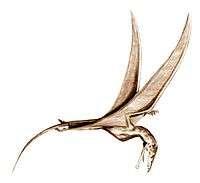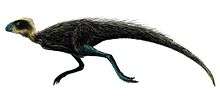Parapsicephalus
| Parapsicephalus purdoni Temporal range: Early Jurassic, 182 Ma | |
|---|---|
 | |
| Fossil skull showing brain endocast (AMNH 1694) | |
| Scientific classification | |
| Kingdom: | Animalia |
| Phylum: | Chordata |
| Class: | Reptilia |
| Order: | †Pterosauria |
| Clade: | †Dimorphodontia |
| Genus: | †Parapsicephalus Arthaber, 1919 |
| Species: | †P. purdoni |
| Binomial name | |
| Parapsicephalus purdoni (Newton, 1888) | |
| Synonyms | |
|
Scaphognathus purdoni Newton, 1888 | |
Parapsicephalus (meaning "beside arch head") is a genus of "rhamphorhynchoid" (long-tailed) pterosaurs from the early Toarcian-age Lower Jurassic Alum Shale of Whitby, Yorkshire, England. It is known from a single partial skull lacking the snout, but including a detailed endocast of the brain.
It was collected in the 1880s by Reverend D.W. Purdon, who is honored in the specific name,[1] and first described by Edwin Tulley Newton, who named it as a species of Scaphognathus, S. purdoni.[2] It was recognized as a distinct genus only decades later in 1919 by Gustav von Arthaber,[3] although in 2003 it was synonymized by David Unwin with Dorygnathus,[4] repeated in a recent popular publication.[5] It has been considered to be a rhamphorhynchid,[6] of medium size (estimated wingspan of ~1 m ~[3.3 ft]),[1] although a more recent estimation suggests it may have had a wingspan of over 2m, [7]
See also
References
- 1 2 Wellnhofer, Peter (1996) [1991]. The Illustrated Encyclopedia of Pterosaurs. New York: Barnes and Noble Books. pp. 77–78. ISBN 0-7607-0154-7.
- ↑ Newton, E.T. (1888). On the skull, brain, and auditory organ of a new species of pterosaurian (Scaphognathus purdoni) from the Upper Lias near Whitby, Yorkshire. Philosophical Transactions of the Royal Society of London, B 179:503-537
- ↑ von Arthaber, G. (1919). Studien über Flugsaurier auf Grund der Bearbeitung des Wiener exemplars von Dorygnathus banthensis Theod Sp., Denkschriften der königlichen Akademie der Wissenschaften. Mathematisch-Naturwissenschaftliche Klasse 97:391-464. [German]
- ↑ Unwin, D. M., 2003, "On the phylogeny and evolutionary history of pterosaurs", In: Evolution and Palaeobiology of Pterosaurs, edited by Buffetaut, E., and Mazin, J.-M., Geological Society Special Publication, n. 217, p. 139-190
- ↑ Unwin, D.M. (2006). The Pterosaurs: From Deep Time. Pi Press:New York, p. 272. ISBN 0-13-146308-X.
- ↑ Carroll, R.L. (1988). Vertebrate Paleontology and Evolution. W.H. Freeman and Company:New York, 698 pp. ISBN 0-7167-1822-7.
- ↑ O'Sullivan, M, Martill, M., and Groodcock, D.A pterosaur humerus and scapulocoracoid from the Jurassic Whitby Mudstone Formation, and the evolution of large body size in early pterosaurs. Proceedings of the Geological Association n. 124, p. 973-981. DOI 10.1016/j.pgeola.2013.03.002



